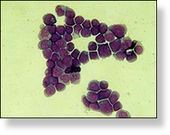
© UnknownLeukaemia targets cells in bone marrow which form blood
Scientists have decoded the complete DNA of a cancer patient and traced her disease to its genetic roots.
The Washington University team identified 10 gene mutations which appeared key to the development of the woman's acute myeloid leukaemia.
Just two of these had been linked to the disease before.
The sequencing technique, described in the journal
Nature, could be applied to other cancers and aid the design of targeted drugs.
The researchers took two samples from the woman in her 50s - who later died from the disease - and examined the DNA for differences.
One sample was taken from healthy skin cells, the other from bone marrow tissue made up of cancerous cells.
They found that virtually every cell in the tumour sample had nine of the key mutations.
Like most cancers, acute myeloid leukaemia (AML) - a cancer of blood-forming cells in the bone marrow - arises from mutations that accumulate in people's DNA over the course of their lives.
However, little is known about the precise nature of those changes and how they disrupt biological pathways to cause the uncontrolled cell growth that is the hallmark of cancer.
Previous efforts to decode individual human genomes have looked at common points of DNA variation that may be relevant for disease risk.
In contrast the Washington team, using a gene sequencing technique, were able to sift through the three billion pairs of chemical bases that make up the human genome to pull out the mutations that contributed to the patient's cancer.
True landmarkGeneticist Dr Francis Collins, a former director of the US National Human Genome Research Institute, called the study a "true landmark in cancer research".
He said: "In the past, cancer researchers have been 'looking under the lamp-post' to find the causes of malignancy - but now the team from Washington University has lit up the whole street.
"This achievement ushers in a new era of comprehensive understanding of the fundamental nature of cancer, and offers great promise for the development of powerful new approaches to diagnosis, prevention and treatment."
Three of the newly-discovered mutations were in genes that normally suppress tumour growth, and four were in genes linked to the spread of cancer.
The other appears to affect the transport of drugs into the cells, possibly fuelling resistance to cancer therapy.
The researchers are still looking for other gene mutations which may also play a part.
They also examined tumour samples from another 187 AML patients, but found none had any of the eight new mutations.
Lead researcher Dr Richard Wilson said: "This suggests that there is a tremendous amount of genetic diversity in cancer, even in this one disease.
"There are probably many, many ways to mutate a small number of genes to get the same result, and we're only looking at the tip of the iceberg in terms of identifying the combinations of genetic mutations that can lead to AML."
The researchers suspect that the mutations occurred one after another, with each pushing the cell closer to malignancy.
Kat Arney, of the charity Cancer Research UK, said: "This is a very important piece of research, not only for our understanding of leukaemia but for many other types of cancer.
"Thanks to advances in technology it is now possible to unlock the genetic secrets within cancer cells, which will be the key to better diagnostic tools and treatments in the future."
Ken Campbell, of Leukaemia Research said: "Although it is very early days, it is realistic to think that these findings could lead to new treatments.
"Its wider application to other cancers may be limited though - the technique is particularly valuable for blood cancers in which the chromosome changes are usually simpler than in solid tumours at the time of diagnosis."
Reader Comments
to our Newsletter